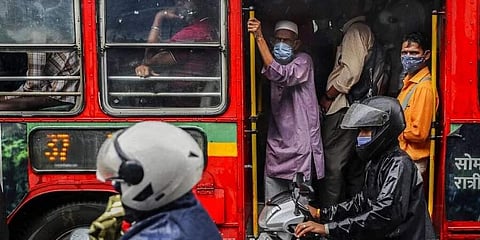

Researchers from the premier Indian Institute of Science (IISc) have developed an ensemble forecast, which is a mathematical model to predict the COVID third wave in Karnataka, by analysing 972 scenarios.
The study has predicted that the new variant could emerge by September to October, and if the present vaccination rate continues, the State Government would have to bring back all COVID restrictions. If the vaccination pace is not increased, the State could see an active case load of 7 to 8 lakhs.
“In this model, due to several uncertainties in terms of COVID spread and missing data, we have drawn several key parameters that are influencing the wave three and varied those parameters to build different scenarios," said Prof Sashikumaar Ganesan, Chairman, Department of Computational and Data Sciences.
The model was developed along with his colleague Deepak Subramani, renowned epidemiologist Dr Giridhara Babu R and PhD students. The model is built on seven key parameters – Case-to-case infection ratio; duration of antibody waning in the population, and different scenarios if it wanes in 1/3rd, 2/3rd and full population; emergence of immune-escaped viral variants in different months starting from July-end till November; reinfection due to new variants; vaccination rates per day if it is the same and adding 50 per cent and 100 per cent increase from the current scenario; and mainly COVID-appropriate behaviour.
Keeping these seven parameters three factors were considered: chances of wave 3 in the State, date of the peak and agewise caseload during the peak. “Three key parameters were observed from the seven, primary being COVID-appropriate behaviour which is most significant; the second is the timing of the new variant and third the vaccination rate," Dr Sashikumar explained.
The study found that good social distancing, no emergence of a new variant and ramped up vaccination are the key to mitigate the third wave. "We have to be watchful for the next three to six months. Genome sequencing and testing are important. If we avoid the emergence of new variants till November, then I don’t really see a peak in Karnataka. But we will definitely see a peak five to six weeks after the emergence of a new variant," he explained.
The study found that in the worst-case scenario if a new variant emerges in August, the State could see 4.51 lakh cases in August and around 20 lakh cases between August 22 and September 10.
If the vaccination remains at the same pace and a new variant emerges, the State, with relaxed social distancing norms, could see between 1.44 lakh and 2.07 lakh cases. However, if the social distancing is good, then there will only be 36,000 cases by October 13 and around 36,000 to 48,000 cases till October-end.
